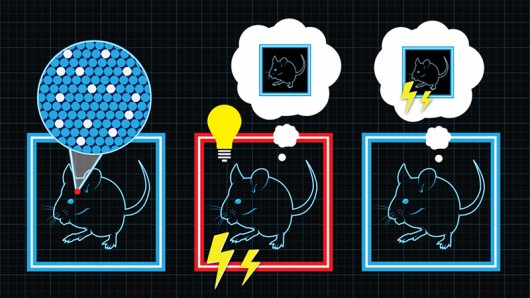
MIT neuroscientists identified the cells (highlighted in red) where memory traces are stored in the mouse hippocampus (Photo: Steve Ramirez and Xu Liu / MIT)
An ongoing collaboration between the Japanese Riken Brain Science Institute and MIT’s Picower Institute for Learning and Memory has resulted in the discovery of how to plant specific false memories into the brains of mice. The breakthrough significantly extends our understanding of memory and expands the experimental reach of the new field of optogenetics.
The ability to learn and remember is a vital part of any animal's ability to survive. In humans, memory also plays a major role in our perception of what it is to be human. A human is not just a survival machine, but also reads, plans, plays golf, interacts with others, and generally behaves in a manner consistent with curiosity and a need to learn.
Forgetting where we put the keys is a standard part of the human condition, but in the last few decades our knowledge of more serious memory disorders has grown rapidly. These range from Alzheimer's disease, where the abilities to make new memories and to place one's self in time are seriously disrupted, to Post-Traumatic Stress Disorder, in which a memory of a particularly unpleasant experience cannot be suppressed.
Such disorders are a powerful force driving research into discovering how healthy memory processes function so that we can diagnose and treat dysfunctional memory function.
In previous work, the team of researchers at the Picower Center for Neural Circuit Genetics were able to identify an assembly of neurons in the brain's hippocampus that held a memory engram, or data concerning a sequence of events that had taken place previously. In recalling a memory, the brain uses this data to reconstruct the associated events, but this reconstruction generally varies slightly to substantially from what actually occurred.
The researchers were able to locate and identify the neurons encoding a particular engram through the use of optogenetics. Optogenetics is a neuromodulation technique that uses a combination of genetic modification and optical stimulation to control the activity of individual neurons in living tissue, and to measure the effects of such manipulation.
The MIT team genetically engineered the hippocampal cells of a new strain of mouse so that the cells would form a light-sensitive protein called a channelrhodopsin (ChR) that activates neurons when stimulated by light. This involved engineering the mice to add a gene for the synthesis of ChR, but that gene was also modified so that ChR would only be produced when a gene necessary for memory formation was activated. In short, only neurons actively involved in forming memories could later be activated by light.
Initial work using the genetically engineered mice focused on determining what neurons in the hippocampus are associated with forming a new, specific memory. There were at least two schools of thought on how memory engrams were stored – locally or globally. They discovered that a memory is stored locally, and can be triggered by optically activating a single neuron.
"We wanted to artificially activate a memory without the usual required sensory experience, which provides experimental evidence that even ephemeral phenomena, such as personal memories, reside in the physical machinery of the brain,” says lead author Steve Ramirez.
The new results came from a chain of behavioral experiments. The researchers identified the set of brain cells that were active only when a mouse was learning about a new environment. The genes activated in those cells where then coupled with the light-sensitive ChR.
These mice were then exposed to a safe environment in a first box, during which time the neurons which were actively forming memories were labelled with ChR, so they could later be triggered by light pulses.
Next the mice were placed in a different chamber. While pulsing the optically active neurons to activate the memory of the first box, the mice were given mild foot shocks. Mice are particularly annoyed by such shocks, so this created a negative association.
When the mice were returned to the first box, in which they had only pleasant experiences, they clearly displayed fear/anxiety behaviors. The fear had falsely become associated with the safe environment. The false fear memory itself could be reactivated at will in any environment by triggering the neurons associated with that false memory.
“Remarkably, the recall of this false memory recruited the same fear centers that natural fear memory recall recruits, such as the amygdala,” says Xu Liu, a post-doctoral fellow and co-first author of the study. The recall of this false memory drove an active fear response in associated parts of the brain, making it indistinguishable from a real memory. “In a sense, to the animal, the false memory seems to have felt like a ‘real’ memory,” he said.
These kinds of experiments show us just how reconstructive the process of memory actually is,” said Steve Ramirez, a graduate student in the Tonegawa lab and the lead author of the paper. “Memory is not a carbon copy, but rather a reconstruction, of the world we've experienced. Our hope is that, by proposing a neural explanation for how false memories may be generated, down the line we can use this kind of knowledge to inform, say, a courtroom about just how unreliable things like eyewitness testimony can actually be." Perhaps they can also provide a solution for the problem of lost keys.
Copyright © gizmag 2003 - 2013 To subscribe or visit go to: http://www.gizmag.com
http://www.gizmag.com/mit-riken-memory-manipulation-in-mice/28542
